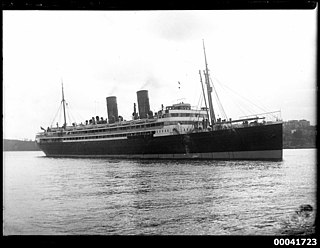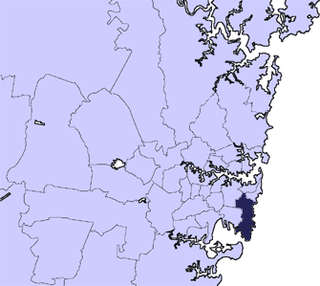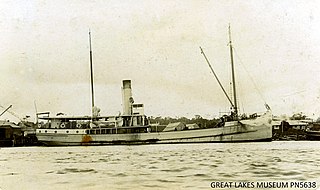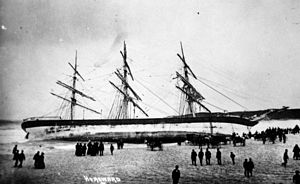
SS Yongala was a passenger steamship that was built in England in 1903 for the Adelaide Steamship Company. She sank in a cyclone off the coast of Queensland in 1911, with the loss of all 122 passengers and crew aboard.

RMS Niagara was a transpacific steam ocean liner, Royal Mail Ship and refrigerated cargo ship. She was launched in 1912 in Scotland and sunk in 1940 by a mine off the coast of New Zealand.

The City of Randwick is a local government area in the Eastern Suburbs of Sydney, New South Wales, Australia located south-east of the CBD. Established in 1859, Randwick is the second-oldest local government area in New South Wales, after the City of Sydney. It comprises an area of 36 square kilometres (14 sq mi) and as at the 2016 census had a population of 140,660.

Maroubra is a beachside suburb in the Eastern Suburbs of Sydney, in the state of New South Wales, Australia. It is 10 kilometres south-east of the Sydney central business district in the local government area of the City of Randwick.

Thomas Rowe was a British-born architect, builder and goldminer who became one of Australia's leading architects of the Victorian era. He was also a politician, who was the first Mayor of Manly.
SS Virawa was British India Steam Navigation Company (BI) steamship. She was launched in Scotland in 1890 and scrapped in India in 1921. Her trades included taking horses from Australia to India, and indentured labourers from India to Fiji and Trinidad. In 1899 she was a troop ship in the Second Boer War.

John Norton was an English-born Australian journalist, editor and member of the New South Wales Parliament. He was a writer and newspaper proprietor best known for his Sydney newspaper Truth. Norton was arguably one of Australia's most controversial public figures ever.

RMS Quetta was an iron-hulled steamship that was built in Scotland in 1881 and wrecked with great loss of life in the Torres Strait in 1890. She was operated by British India Associated Steamers (BIAS), which was controlled by the British India Steam Navigation Company (BISN). She was wrecked on a previously unknown rock, which has been called Quetta Rock ever since. The Underwater Cultural Heritage Act 2018 protects the wreck.

Queen of Nations was a wooden-hulled, three-masted clipper that was built in Scotland in 1861 and wrecked on the coast of New South Wales in 1881. She spent her entire two-decade career with George Thompson, Junior's Aberdeen White Star Line.
Maroubra Speedway, officially known as Olympia Motor Speedway was a motor racing venue in the Sydney suburb of Maroubra, New South Wales, Australia and was reported to have had a capacity of 70,000.
The Advance was a composite schooner built in 1874 at Auckland, New Zealand, that was wrecked when she drifted onto rocks at Henrys Head, Botany Bay, New South Wales, Australia, on 12 June 1902, whilst carrying ballast between Wollongong and Newcastle, New South Wales.

The Comboyne was a wooden screw steamer built in 1911 at Tuncurry, that was wrecked when it struck an object whilst carrying timber to Wollongong and was lost at approximately 1 mile (1.6 km) off Bass Point, Shellharbour, New South Wales on 27 November 1920.

HMAS Grantala was a passenger steamship that was built in England in 1903 as a coastal interstate liner for the Adelaide Steamship Company. In 1914 the Commonwealth government requisitioned her as a Royal Australian Navy hospital ship.

Hesperus was an iron-hulled, three-masted, passenger clipper ship that was built in Scotland in 1874 and scrapped in Italy in 1923. She was built for Thompson and Anderson's Orient Line service between Great Britain and South Australia.

South Australian was a composite-hulled clipper ship that was built in Sunderland in 1868 and sank in the Bristol Channel in 1889. She was a successor to clippers St Vincent and City of Adelaide. For nearly two decades she voyaged annually between London and South Australia.

SS Collaroy was an iron paddle steamer which often travelled between Newcastle and Sydney. The ship was named after a sheep station near Cassilis in the Hunter Valley, Australia. It was launched in 1853 in Birkenhead, England. The ship's name is now the location of the present day suburb of Collaroy.

Sixty-miler (60-miler) is the colloquial name for the ships that were used in the coastal coal trade of New South Wales, Australia. The sixty-milers delivered coal to Sydney from ports and ocean jetties to the north and south. The name refers to the approximate distance by sea—actually 64 nautical miles—from the Hunter River mouth at Nobbys Head to the North Head of Sydney Harbour.
Queen Cristina was a steam cargo ship built in 1896 by Bartram & Sons of Sunderland for Thomas Dunlop & Sons of Glasgow. The ship was designed and built for general cargo trade and spent her career doing tramp trade. She was named after Queen Cristina of Spain, and was the first ship named Queen Cristina in service with the Queen Line.















